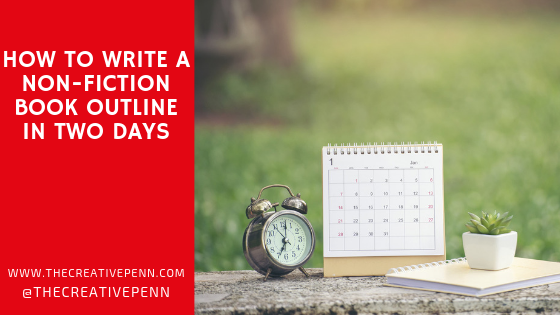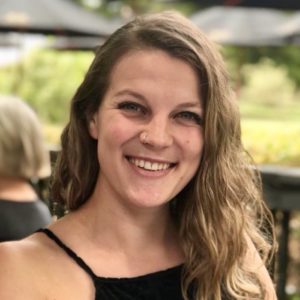Writing a non-fiction book can be as challenging as writing fiction, but in different ways. How do you organize all you know in a way that will assist your readers? Esbe van Heerden shares some great tips about a quick method to create a comprehensive and easy-to-use outline.
 If you’re in the early stages of planning out your book, you probably have a really good idea of what you want your book to be about, but when you sit down to write it you feel totally overwhelmed.
If you’re in the early stages of planning out your book, you probably have a really good idea of what you want your book to be about, but when you sit down to write it you feel totally overwhelmed.
You know that all the information on your topic is in your head, but you have no idea where to start or how to put it all down into a logical order.
But what you can already do, is summarize what you’d like your book to be about — what you’d like it to teach others, what you want your readers to get out of it.
Based on this summary, you can reverse engineer exactly what specific information to include in your book so that your readers reach the destination you’d like them to reach by the time they’ve finished reading your book.
That’s why we call this system of outlining your book the Reverse Summary Technique.
This technique can also be used to create the outline to your audiobook, keynote speech and even a course!
I’m going to show you how to create an outline that will be the backbone of your entire book as you go through the writing and editing process — in 2 days.
How You Can Use The Reverse Summary Technique
After using the Reverse Summary Technique, you can easily make:
- Your sales copy for the blurb on the back of your book and your Amazon sales page
- A complete working Table of Contents
- A list of all the points you want to make in each chapter, including back up statements and arguments, and which stories you want to place throughout your book
- A catalog of materials you want to reference as downloads to gain email opt-ins
- A guide for exactly what to write as you move into the writing process, and for how to organize your finished book during the editing phase
Lay a solid foundation using the Reverse Summary Technique that will support you, and will make what could be the very difficult steps of writing and editing much easier
The 5 Steps to Using the “Reverse Summary Technique” to Build the Backbone of Your Book
 There are 5 steps to the Reverse Summary Technique:
There are 5 steps to the Reverse Summary Technique:
Step 1: Summarize your book
Step 2: Breakdown your summary into a Table of Contents
Step 3: Summarize each chapter
Step 4: Break down each summary into supporting points
Step 5: Write out questions that will help prompt you
Step 1: Summarize your book
There are a number of ways you can pull out your book’s summary — below are some prompts to help you really think about what you want your book to achieve in your reader’s lives. Answer any of the following that resonate with you, there is no need to answer all of them as you will find the answers repetitive!
What will your book be about?
- What is your expertise in?
- Why are you qualified to talk about this topic?
- What are you hoping the reader will get out of your book by the end of it?
- Why would a reader want to pick up your book?
- What journey will your reader go on?
What are the main ideas and take away points you foresee in your book?
- Are you trying to convince your readers of a certain view?
- Are you opening up your reader’s mind to something?
- Do you want them to know exactly what action steps to take next?
- What will your audience specifically get by reading your book?
- Describe how you want your audience to feel at the end of your book, what do you want them to get out of it?
- How would you want someone, who has read your book, to summarize it to their friends in only a sentence or two?
- If someone had your book, and a friend asked them what your book was about, how would you want the person to answer? eg. “Jane’s book is about…”
 Use all of your answers above to get your main ideas for your book. Aim for 3 or 4 main take away points, themes or ideas here.
Use all of your answers above to get your main ideas for your book. Aim for 3 or 4 main take away points, themes or ideas here.
You may come up with something like this:
My book’s four main takeaways should be:
1. My methodology, what it is and what it means to families.
2. Skills and tools to apply immediately in order to contribute to their loved ones and their own recovery.
3. Understand the family’s role in a loved one’s recovery and what it takes to contribute to recovery.
4. How my philosophy and method brings love alive in their own and their family’s lives and empowers the growth of recovery.
Step 2: Breakdown your summary into a Table of Contents
Now that you have your book summary, take the three main points/takeaways that you came up with, and explain each point in 3 or 4 sentences.
From each of these sentences, there should be a main idea — use these ideas as chapter headings!
For example, you may explain the first point above as follows:
The main takeaway: My methodology, what it is and what it means to families.
The summary: My Methodology is not tough, conditional, or complicated. It is not enabling or steeped in denial. My Methodology is peaceful, clear, based on facts, aware of reality, and willing to quietly risk all for a better tomorrow, while staying grounded in today. This is the most powerful path to walk with a struggling loved one and the most promising. This is My Philosophy.
Take each sentence you used to summarize the takeaway, and pinpoint the main idea — the bolded terms above show the main points, and can be used to make chapter titles, for example:
- My Methodology — What Does it Mean?
- The Power of Today to Create a Better Tomorrow
- The Promise of the Path
- My Philosophy
 If you’d repeated this process for each takeaway point, already, you would have progressed so far from just an idea of the transformation you want your readers to go through, to an established Table of Contents. But we aren’t stopping there!
If you’d repeated this process for each takeaway point, already, you would have progressed so far from just an idea of the transformation you want your readers to go through, to an established Table of Contents. But we aren’t stopping there!
Step 3: Summarize each chapter
In order to get even more granular, create your supporting arguments by summarizing each chapter. Just as you wrote down a summary of your book in the last step, now do the same for each chapter.
As an example, taking the first chapter from step two:
Chapter 1: My methodology — what does it mean?
Summary: My Methodology is all about walking the loving path from chaos to sanity, it gets you from overwhelmed, worried you’re going to lose your loved one, to a place of control. It’s about selfless love, truly selfless, which is so scary. I want to show you how to take that risk of loving someone selflessly. I want to show you how to use the calendar so that you can continue to be present in order to stay on this path.
Move on to step 4 to see how to use this summary to get your chapter’s supporting arguments.
Step 4: Break down each summary into supporting points
Once you’ve summarized each chapter, find the key arguments and turn them into your main supporting points. In the summary above, these have been bolded.
Turn the key arguments into subheadings, for example, from the summary in Step 3:
- From Chaos to Sanity
- Selfless Love
- How to Take That Risk
- Use the Calendar
Use these subheadings to easily get into the zone — with them, you’ll never sit down for a writing session just to wonder what you should write about.
To take this one step further, add prompts in the form of questions. Read on to Step 5 to see how. This way, when you go to write each chapter, all you’ll have to do is answer each question you’ve written to get the content to flow from your head. You’ve got the information in there, and now you’ll be asking yourself the right questions.
Step 5: Write out questions that will help prompt you
 For each point, what would you need to ask yourself in order to talk about that particular point? With each point you want to make, try to write questions that will not only answer what that main point is, but also why that point is important to the reader.
For each point, what would you need to ask yourself in order to talk about that particular point? With each point you want to make, try to write questions that will not only answer what that main point is, but also why that point is important to the reader.
For example, for each point you may ask yourself:
Why does the reader need to know that?
What happens if the reader doesn’t know that, if they tried to do XYZ without that information.
With this question, the answer you’re aiming for will paint how bad it is when the reader doesn’t take your advice, and then paint how good it can be when they do take your advice.
For example, taking Chapter 1 and a couple of its subheadings from the steps above, it might look something like this:
My Methodology — What Does It Mean?
From Chaos to Sanity
- What is My Methodology?
- What does it mean to be in chaos? What does that look like for the reader? What does sanity look like?
- How does My Methodology get the reader from chaos to sanity?
- Why is it important to have a path that gets you from chaos to sanity?
- Is there a story I can think about, either in my life or the life of someone I know, that exemplifies what chaos looks like, and how this path helped move someone from there to sanity?
Selfless Love
- What does it mean to selflessly love? What does that look like?
- What does selfish love look like?
- What are some examples of both?
- Why is it important for the reader to learn what selfless love is, how can it help them on their journey to family recovery?
This entire process will probably take you a few hours, but I recommend coming back to it again in day 2, just in case something comes to you overnight!
Writing questions like will make life so much easier when you come to writing your content. Just by answering the questions you come up with in step 5 in a few paragraphs, suddenly you may have a 50,000-word manuscript, filled with all the important information.
And just as importantly, because it was planned so well from the start, your first draft will also be filled with only the important information.
Planning your book’s outline using the Reverse Summary technique, will allow you to be as efficient as possible in the writing phase, which will make editing a breeze!
It ensures that you don’t repeat information, and don’t have to spend a long time cutting your manuscript back down after you’ve waffled on about things that just don’t matter to your book’s main thesis.
Most importantly, you will never sit down behind your keyboard and draw a blank. You’ve always got your cues waiting for you so that the information will flow through your fingers and onto the page.
[Note from Joanna: You can find lots more help on how to write non-fiction here. ]
Do you outline before you write non-fiction books or articles?
Please leave your thoughts below and join the conversation.
 Esbe van Heerden heads up Author Success over at NonFiction Audiobook, where she’s in this to make a difference, to help you create an audiobook you truly love — one that is one-of-a-kind, unique and brilliantly made by you.
Esbe van Heerden heads up Author Success over at NonFiction Audiobook, where she’s in this to make a difference, to help you create an audiobook you truly love — one that is one-of-a-kind, unique and brilliantly made by you.
Whether you want your message to reach the masses, whether you’re starting or growing your business, or whether you just want to charge more so you can work less, Esbe is here to help you reach the highest levels of your creative potential and tap into the deepest wisdom within you while she takes care of the complicated processes.
Esbe is an unshakable yeasayer dedicated to helping you make your best audiobook — so that it’s sound and sophistication honors your story within. To find out more about making your audiobook, visit NonfictionAudiobook.com
